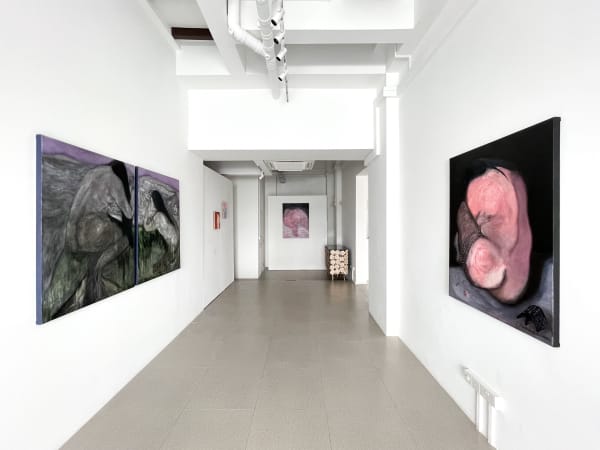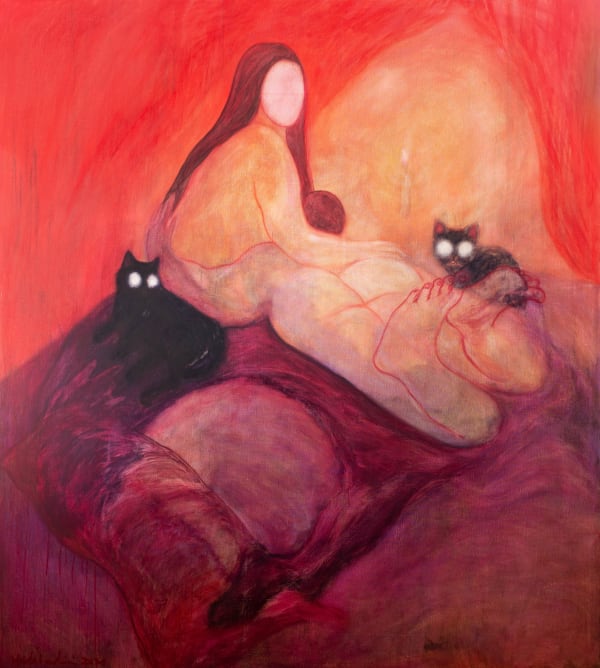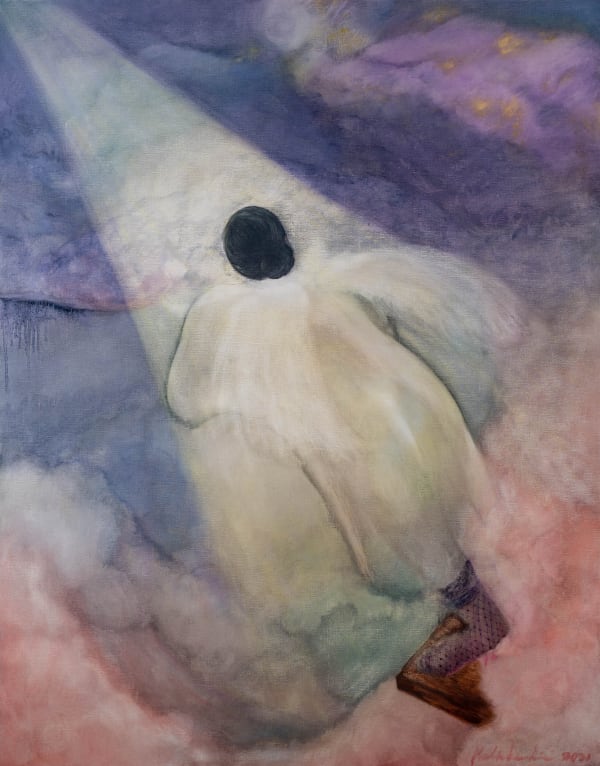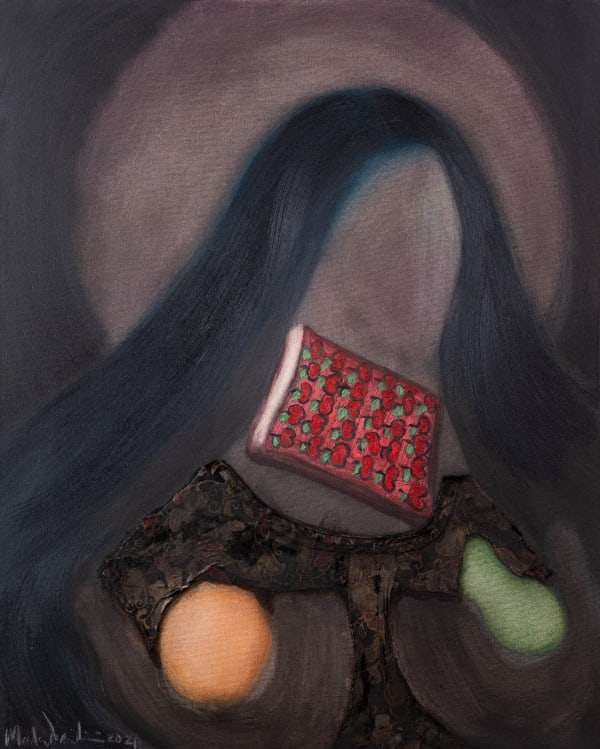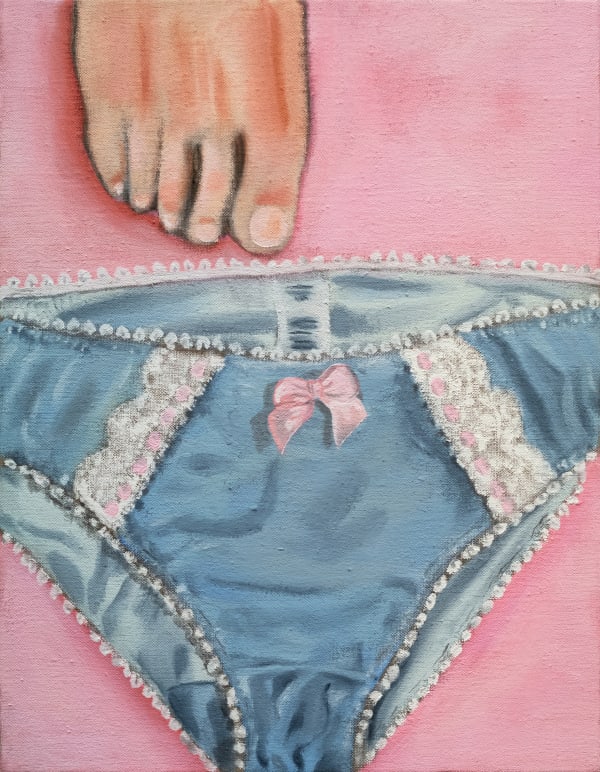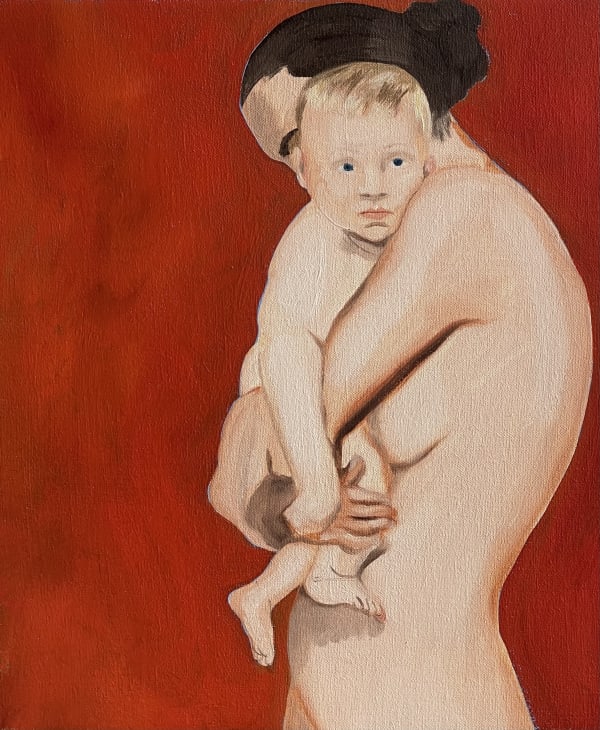You Can Tell Me: Marla Bendini & Victoria Cantons
Curated by John Silvis
As a life-long contributor to the art world, I recently found myself asking what it is that we expect from art when we are looking at it. Is it the anticipation of a new insight, momentary elan, or a transformational experience from an exhibition that compels us? Or is it a specific work that will captivate us or trigger us phenomenologically? Applying this inquiry on a broader social scale begs the question of what the core motivation of the cultural enterprise is and how we are enriched by images, music, film or choreography? For some, art might be solely a form of entertainment, for others art is a channel to experience the divine, and has the capacity to tap into an emotional reality that can be drowned out by the veneers of everyday life, offering itself as a conduit to the unseen realms that become visible.
The exhibition You Can Tell Me, at Cuturi Gallery, Singapore, features two painters, Marla Bendini (b. 1986, Singapore) and Victoria Cantons (b. 1969, UK), who both deliver on these cultural aspirations by presenting deeply personal and relevant artworks that move the needle forward regarding the conversation around gender. Although each artist is operating in their own unique cultural arena, they are symbiotically engaging with the historicity of the female gaze in painting. For millennia the female body has been the object of consumption in art and literature, a malleable subject seen mostly through an almost exclusively masculine lens. Profound discussions within the intellectual discourse surrounding the power of the female psyche have transformed societal norms on a global scale. However, achieving this equilibrium in the art world is far from accomplished; and there is still much work to be done in expanding the embrace of gender identity as spectral reality in contemporary art.
Positioning Cantons and Bendini in the current feminist discourse expands the commentary on the urgency of critical feminist theory to include women of diverse racial, cultural and sexual backgrounds. The term intersectionality has been used in reference to overlooked corners of society, and cutting edge theorists, such as Paul Preciado, envision an evolution of society that will champion a non-binary gender regime. The term transgender has historically referred to people who defy prescribed societal frameworks regarding gender. And yet, as we open up our understanding of gender in all its forms, the term will hopefully represent an immensely inclusive ecosystem that nurtures all of its participants.
Cantons’ practice is emblematic of the London art scene that has for several decades been at the forefront of pushing social boundaries. She is building on a formidable legacy of painters, such as Jenny Saville and Lucien Freud, who have used the figure as a powerful site for communication; and her work is able to access both the poetic and cerebral side of embodied presence. She states that: “When I look around me, I don’t hear someone else voicing want I need to hear,” and under this mantra creates with a clear and unique vision as a figurative painter. Observing her trajectory in painting, the recent work directly interfaces with the global conversation surrounding new ways of approaching the figure in painting. The through line of her practice is the struggle, in her own words, of a woman with a transgender history. In her work, Le Visage de L'amour or The Maze, 2021, we see two female figures captured in a moment of quiet intimacy as they stand in front of a floral painting. The word captured seems like an apt way to talk about many of her compositions, as she works with photographs to arrest certain details of larger scenes. The wall paper has a maze pattern, suggesting that there is some form of negotiation that is simultaneously happening in this quiet moment and metaphysically. There is an undefined hand emerging from the left side of the frame which can be read as coming or going from the event, there is a sense of the embodiment of gender as transitional reality, rather than a static resting point; there is a wonderment of the body that is appreciated in its totality.
The seriousness of her work is rooted in her voracious knowledge of literature and art history, encapsulated within the large tableaus that imply a complex progressive narrative. We see this play out between multiple figures, which are rendered as strong forms and exude an emotional weight with their presence. Canton refers to the three smaller works in the exhibition as soft armor paintings. The expected paradigm of a portrait is upended by covering the entire head and bust with fabric, obliterating a view of the person. It introduces the notion that the body is simultaneously strong and malleable, and can easily be veiled by didactic cultural coverings. The cinematic qualities in her work tease out a world in which the feminine is heroic, beyond subjugation, and free to evolve as she needs. There is a forward motion and poetry in the way she paints her figures that is laden with exhilarating and inspiring energy, an emancipated ethos enacted through transition.
This journey of liberation is mirrored in the works of Singapore artist Marla Bendini. The viewer is invited to engage with Bendini’s figures that are in constant flux, revealing layers of exuberant transformation that define new spaces of power within the feminine soul. Bendini’s painterliness evokes tenderness that softens the intensity of the intimate struggle. There is a felt desire for transparency, both conceptually and emotionally. In her own words, she has described her process this way: “The Universe has stripped me of everything I knew, made me learn how to be silent, how to let go, how to move on, how to stand my ground, how to be more understanding, how to fight, how to survive, how to be more assertive, more loving, less naive.”
A poignant painting by Bendini hanging in the center of the first gallery, Pillow Talk / It Is Safe to Look Within, 2021, exemplifies the emotional depth in her most recent series of paintings. The dreamlike scenario pictures a seated female figure intertwined with a second undefined protagonist, who are flanked by two cosmic cats that appear to be very comfortable in their surroundings. The dominant red and black tones of the paint elicit a visceral intensity that can be uncomfortable. However it proves to be rewarding for those willing to enter into this private space. The emotional depth of her practice separates Bendini from her more obtuse contemporary peers and the beauty of her oeuvre exists in the spaces between fantasy and reality, mystery and definition. The approach she takes to painting is an act of invitation to consider the meandering path to wholeness and presence.
In Bendini’s recent painting, My Sisters Have Taught Me And Reminded Me Of What I Already Know, 2021, we see that the struggle is richer when carried out in the company of others. The central, mysterious figure of this painting is surrounded by matriarchal bodies that seem to gently lecture and support the vulnerability of a younger soul. The monochromatic application of paint is evidence of this as a serious, metaphysical endeavor. We sense an empowering earnestness across much of the work, one that is completely absent of the cynicism that can exist within gender theory. In her work, we are presented with an incredibly generous vision of the beauty within the human spirit. In spite of a visible wrestling with self doubt, gender grids or imposed trauma, she emerges in celebration of a new identity that is free from any archetypal validation. InThis Beloved Is A Spirit That Cannot Be Broken, 2021, the artist reveals her face to us as a gesture of openness, or of being content to engage with the world. Bendini’s vision of the future is one characterized by art that dares to plum the depths of human consciousness.
-
 Marla Bendini, Pillowtalk / It Is Safe To Look Within, 2021
Marla Bendini, Pillowtalk / It Is Safe To Look Within, 2021 -
 Marla Bendini, The Pink Clouds Won't Last Forever But You Can Still Hold On To How It Feels, 2021
Marla Bendini, The Pink Clouds Won't Last Forever But You Can Still Hold On To How It Feels, 2021 -
 Marla Bendini, The Eyes Are The Nipples Of The Face, 2021
Marla Bendini, The Eyes Are The Nipples Of The Face, 2021 -
 Marla Bendini, My Dark Mother, 2021
Marla Bendini, My Dark Mother, 2021 -
 Marla Bendini, Stealth / Where Do Wounded Soldiers Go?, 2021
Marla Bendini, Stealth / Where Do Wounded Soldiers Go?, 2021 -
 Marla Bendini, Transactional Patterns, 2021
Marla Bendini, Transactional Patterns, 2021 -
 Marla Bendini, Goddess Amplified, 2021
Marla Bendini, Goddess Amplified, 2021 -
 Marla Bendini, This Beloved Is A Spirit That Cannot Be Broken , 2021
Marla Bendini, This Beloved Is A Spirit That Cannot Be Broken , 2021 -
 Marla Bendini, Where Do Prayers Go? / This Is Not The End, 2021
Marla Bendini, Where Do Prayers Go? / This Is Not The End, 2021 -
 Marla Bendini, My Sisters Have Always Taught And Reminded Me What I Already Know, 2021
Marla Bendini, My Sisters Have Always Taught And Reminded Me What I Already Know, 2021 -
 Victoria Cantons, Le Visage De L'amour or The Maze, 2021
Victoria Cantons, Le Visage De L'amour or The Maze, 2021 -
 Victoria Cantons, Read The Rules Of Engagement And Don't Start To Doubt Them, 2021
Victoria Cantons, Read The Rules Of Engagement And Don't Start To Doubt Them, 2021 -
 Victoria Cantons, Don't Be Afraid Of The Voice In Your Head And Do Turn Your Face Towards The Sun, 2021
Victoria Cantons, Don't Be Afraid Of The Voice In Your Head And Do Turn Your Face Towards The Sun, 2021 -
 Victoria Cantons, Don't Forget A Bad Memory But Don't Lose The Happiness Of The Moment, 2021
Victoria Cantons, Don't Forget A Bad Memory But Don't Lose The Happiness Of The Moment, 2021 -
 Victoria Cantons, Sehnsucht, 2020
Victoria Cantons, Sehnsucht, 2020 -
 Victoria Cantons, See Death, See Life, See Day From Night, 2021
Victoria Cantons, See Death, See Life, See Day From Night, 2021
-

New from Emerging Artists
Artsy, November 20, 2021 -

Women Artists to Watch
Artsy, November 20, 2021 -

Behind the art: Transgender artist Marla Bendini on her journey to finding her true self
Venkat Gunasellan, Honeycombers, October 28, 2021 -

Powerful And Critical Relook At Femininity and The Female Gaze at Cuturi Gallery
Jolene Teo, Alien Space Crab, October 4, 2021 -

You Can Tell Me
Dewi Nurjuwita, Timeout Singapore, September 24, 2021 -

VISIT AN EXHIBITION EXPOUNDING ON THE FEMININE GAZE
Keng Yang Shuen, Female Singapore, September 19, 2021 -

Clifford Chance Virtual Pride Art Gallery 2021 – Singapore
Clifford Chance, June 16, 2021 -

INFLUENCERS: In Conversation with Artist Marla Bendini
Joseph Low, Luxuo, June 1, 2021 -

Six artists reshaping our way of seeing: Victoria Cantons
Baya Simons and Rosanna Dodds, Financial Times, April 26, 2021




